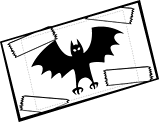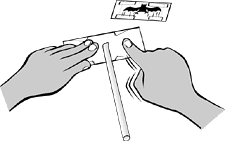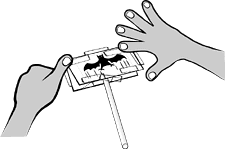|

 Print-out the "Flipstick Cartoons".
Click Here
to go to the Cartoon page, then carefully
cut along the dotted lines.
Print-out the "Flipstick Cartoons".
Click Here
to go to the Cartoon page, then carefully
cut along the dotted lines.
 Choose one set of cartoons--picture
A
and picture
B.
You can color them if you want.
Choose one set of cartoons--picture
A
and picture
B.
You can color them if you want.
 Tape each picture to a file card.
Tape each picture to a file card.


 Turn the first file card over, so
the picture is facedown. Put the pencil, straw, or chopstick in the center
of the card, about 1 inch from the top, and tape it down.
Turn the first file card over, so
the picture is facedown. Put the pencil, straw, or chopstick in the center
of the card, about 1 inch from the top, and tape it down.

Use plenty of tape. (If you're using a straw, you may want
to flatten it a little before you tape it down.)
|
 Now tape the two cards back to back.
Lay the second card over the first, picture side up. Tape the top and sides
of both cards together.
Now tape the two cards back to back.
Lay the second card over the first, picture side up. Tape the top and sides
of both cards together.

Tape the bottom of each card to the pencil. You're going
to twirl the pencil, so use plenty of tape--otherwise the cards might fly
off.
 Hold the pencil between the palms
of your hands and twirl it. The picture changes! (You may need to play around
with your twirling to find the best speed. Keep your thumbs flat against
your fingers so they don't hit the card when you twirl.)
Hold the pencil between the palms
of your hands and twirl it. The picture changes! (You may need to play around
with your twirling to find the best speed. Keep your thumbs flat against
your fingers so they don't hit the card when you twirl.)

If a light is flashing on and off more than thirty times
a second, you see it as a steady light--you don't notice the flickering.
When you watch a movie, the screen is dark about half the time. But because
the bright picture is flickering seventy-two times a second, you don't even
notice the moments of darkeness between the pictures.
|
|

Why does your Flipstick work?
When you look at a picture, then quickly flip to another
picture, your eye and brain remember the first picture for a fraction of
a second, and blend it with the second picture. This visual ability, known
as
persistence of vision
,makes the pictures in movies appear to
move.
When you watch a movie, the light from the projector is
flickering 72 times a second. Your eye and brain blend the flickering frames
of the movie to make a single moving picture.
|